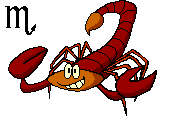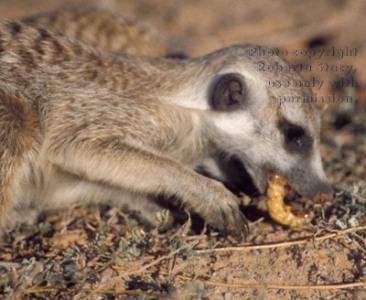Nutrition (What do I eat?)


 When
a meerkat scents prey in the ground, they dig with their long
claws, sending dry soil in the air. Sometimes, where a hole may
hide a rich reward, such as geckos, two meerkats may join
forces. With their excellent sense of smell meerkats can find
food even when they are hiding underground! They have a home of
four square miles hunting a different area each day. Each
meerkat must find its own food, but they may share the task of
capturing and eating a large prey item. Meerkats are known for
their daring diet in which they are able to kill and eat
venomous
snakes and scorpions without getting hurt! They
are immune to the venom. Also, meerkats are able to survive
without drinking water because they get the moisture that they
need through eating roots, tubers, or fruits. Meerkats mostly
feed on things from the ground like insects, grubs,
spiders,
and millipedes. But occasionally they will eat smaller animals,
birds, rodents, reptiles, snails, or bulbous roots. Meerkats
are heterotrophic meaning that they don’t produce their own
food. Meerkats are also endothermic meaning that they are
warm-blooded animals. They forage regularly for these items,
digging in soil and grass and overturning rocks. Their animal
diet consists of 82% insects, 7% arachnids, 3% centipedes, 3%
millipedes, 2% reptiles, and 2% birds. Captive meerkats will
prey readily upon small mammals. Therefore a meerkat is a great
example of a carnivore. Meerkats are an important link in the
food web because they provide food for predators. They also
take many invertebrates acting as a control on their own prey
populations. * Below: This picture was
taken at the Milwaukee County Zoo, where Sashie had just
received her meal from the zookeepers.
When
a meerkat scents prey in the ground, they dig with their long
claws, sending dry soil in the air. Sometimes, where a hole may
hide a rich reward, such as geckos, two meerkats may join
forces. With their excellent sense of smell meerkats can find
food even when they are hiding underground! They have a home of
four square miles hunting a different area each day. Each
meerkat must find its own food, but they may share the task of
capturing and eating a large prey item. Meerkats are known for
their daring diet in which they are able to kill and eat
venomous
snakes and scorpions without getting hurt! They
are immune to the venom. Also, meerkats are able to survive
without drinking water because they get the moisture that they
need through eating roots, tubers, or fruits. Meerkats mostly
feed on things from the ground like insects, grubs,
spiders,
and millipedes. But occasionally they will eat smaller animals,
birds, rodents, reptiles, snails, or bulbous roots. Meerkats
are heterotrophic meaning that they don’t produce their own
food. Meerkats are also endothermic meaning that they are
warm-blooded animals. They forage regularly for these items,
digging in soil and grass and overturning rocks. Their animal
diet consists of 82% insects, 7% arachnids, 3% centipedes, 3%
millipedes, 2% reptiles, and 2% birds. Captive meerkats will
prey readily upon small mammals. Therefore a meerkat is a great
example of a carnivore. Meerkats are an important link in the
food web because they provide food for predators. They also
take many invertebrates acting as a control on their own prey
populations. * Below: This picture was
taken at the Milwaukee County Zoo, where Sashie had just
received her meal from the zookeepers.

Amanda Hustad Copyright © 2007, Design by: Sunlight webdesign